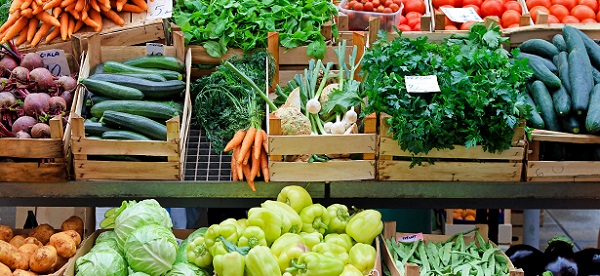Why You Should Eat Organic Food

I’ve written about the importance of drinking clean water and now I am going to talk about the importance of eating organic food. I can’t tell you how important it is to your health to consume the cleanest possible food available. This means eating fresh food that is free of the contaminants found in typical grocery produce and processed food products.
Conventional farming is an industrialized approach towards agriculture. It is oriented towards generating the highest yield of edible product from the farm to consumers. To enable this practice, herbicides (weed killers), insecticides (bug killers), and fungicides (disease killers) are all used to minimize the amount of food lost to competing organisms. But at what cost to human health?
Heavy pesticide use began in earnest in the 1940’s and ‘50’s with the emergence of big chemical companies that had the money to market aggressively to farmers. Over the decades, there has been a lot of debate about the Environmental Protection Agency’s (EPA’s) standard for establishing the safety levels for human tolerance of these chemicals’ residue on food. Because of the variety of chemicals used to grow food, the impact on human health is probably greater than realized or properly evaluated.
Herbicides in Food
Herbicides are weed killers that are usually considered harmful substances. The most widely recognized herbicide is glyphosate, commonly known as Roundup. A staggering estimate of 1 million pounds of this product is used annually both agriculturally and on residential yards. Glyphosate takes days to weeks to chemically breakdown and is not easily dissolved by large amounts of water.(1) This means it doesn’t wash away easily.
While glyphosate is considered a relatively safe product in and of itself, an article published in Scientific American in 2009 reported on an analysis of the combination of glyphosate and the other so-called inert chemicals found in Roundup. The report concluded that at least one of these ingredients, polyethoxylated tallowamine, or POEA, was extremely toxic to human cells, especially embryonic cells.(2)
Insecticides in Food
Insecticides are chemicals that are designed to kill insects, as well as their eggs and larvae. In Arizona it is a fairly common practice to have an exterminator come and spray your yard and/or house for pests. Those companies are using insecticides.
There are many classifications of insecticides made up of various compounds. The compounds commonly known as organophosphates attack the nervous system of the insect being targeted. These are fairly common insecticides. Organochlorides are similar in action to organophosphates. Introduced in 1944, the most controversial organochloride is commonly known as DDT. It was banned from use in 1972 after it was recognized as being responsible for the destruction of American Bald Eagle and California Condor populations.
Fungicides in Food
Fungicides are chemicals that kill fungi, mold, and mildew. Sulfur is a common fungicide. Sulfur is used in gunpowder, matches, and fireworks. Fungicides are often used in combination with other chemical compounds.
Problems with Agricultural Chemicals
EPA standards for agricultural chemicals may not be adequate to properly evaluate the dangers that individual chemicals pose to humans. Nor do they assess the impact of chemical solutions that include multiple chemical substances.
Sometimes the effects and impact of agricultural chemicals take years to understand.
Because many agricultural chemicals are fat-soluble substances, they can collect in the fat cells of any organism in the food chain, including humans, and have a cumulative impact throughout the ecosystem. Fat-soluble substances are very difficult for the liver and kidney to clear out of the human body. Therefore, they can linger in our cells for quite some time.
Insecticides also kill innocuous insects such as bees and butterflies and may be responsible for the decline in beneficial pollinating insects, in general.
Why Eat Organic?
Now I ask you: Would you put Roundup into your salad dressing and pour it on your dinner salad? I suspect not. If it kills weeds, imagine what Roundup would do to the mucosal lining of your stomach.
Would you invite your exterminator to spray chemicals into your refrigerator and then eat that food? I doubt it. If insecticides attack an insect’s nervous system, imagine what it would do to your nervous system.
Would you willingly ingest a chemical that can negatively affect the entire food chain? Or is responsible for destroying entire populations of birds or wiping out beneficial insects like bees?
So why buy a food that has been saturated throughout its growth cycle in these chemicals? That chemical residue is still on the food during and after delivery to your grocery store. It doesn’t go away. Just because you can’t perceptibly see or taste it doesn’t mean it isn’t there. And washing your fruit and vegetables may not be enough to remove a substance that is difficult to dissolve in water.
The only sensible course of action is to buy certified organic fruit, vegetables, and grain products. The USDA and a few other reputable organizations, like Oregon Tilth, can independently verify and certify that a food has met the standards for classification as organic.
Because of this extra level of authentication, organic food does indeed cost more money. But when you consider the long-term potential risks to your health, many of which may not be identified for years to come, eating organic food is preventative medicine.
My approach to buying organic food is this: If the fruit, vegetable, grain, or seed has a thin skin (whether you are peeling it or not), then buy organic. Thin-skinned foods include berries, onions, scallions, lettuces, corn, grains, and rice. If the produce has a thick skin that you will be removing before consuming (like citrus, banana, coconut, avocado, or melons, for example), then buying organic may not be as critical.
There is a list of foods known as the “Dirty Dozen.” These foods have the highest levels of chemical residues and should absolutely be purchased as organic. They are: Strawberries, spinach, apples, nectarines, pears, peaches, grapes, cherries, tomatoes, sweet bell peppers, potatoes, and hot peppers.(3)
If grocery store prices are just too high for the “Dirty Dozen” and other fresh produce, it would be worthwhile to investigate the offerings at local farmers’ markets. You may have to do independent research on growers and their practices to be sure you are indeed purchasing chemical-free food. However, once you do figure out the best sources, you will have amazingly fresh food while supporting your local economy too.
(1) https://www.sciencedirect.com/science/article/pii/S0025326X14000228
(2) https://www.scientificamerican.com/article/weed-whacking-herbicide-p/
(3) https://www.ewg.org/foodnews/dirty-dozen.php
All images from Depositphotos


